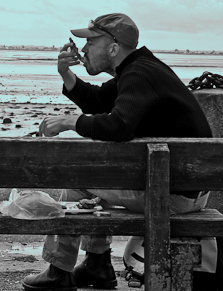Joe Ray
Food & Travel / Words & Photos

Sunday, October 05, 2008
Doing it for the right reasons
I recently interviewed American food icon Alice Waters for a story I’m working on – Alice is down on France – particularly on the way the farming industry is run – now preferring to go to Italy where they still “get it.â€
She should meet Baptiste Vasseur, an organic farmer in Belle Ile’s tiny town of Kerzo.
I met Vasseur, 26, while wandering the cliffs of Belle-Ile. He was out there with his friends, 100 feet above the ocean, fishing for the sea bass known as bar and “whatever else will bite†using shore casting rods to cast their bait a country mile out into the water. How they got the fish up to the top of the cliff remained a mystery.
Vasseur is in his second year of production on his farm with no name, now harvesting late-season tomatoes along with eggplant, cabbage, leeks, turnips, pumpkins and spuds.
It seems a lonely existence for a young guy (Kerzo is a tiny town on an island with a total population of only about 5,000 and mainland France is alternately known as “The Continent†or just “The Other Sideâ€), so why here?
“I’ve got some family here, but mostly I just like it,†he explained. “I found a farm, I studied to make sure it was going to work and got a farmer’s loan. We’ve got a lot of debt, but the loan helped us get going.â€
I ask the same question everyone eventually asks me as a freelance journalist: “You can make a living doing this?â€
“I sell in the market in Le Palais, to restaurants, at the farm itself, and once a week a group of island farmers sells at the aerodrome. That’s it – that’s all I can grow.
What he doesn’t say (I’ll later learn this from chef Epron, who buys Vasseur’s tomatoes for his restaurant, La Table de la Desirade) is that some jerk once came by and poured pesticide in the cistern Vasseur uses to water his plants. This could strip a farmer of his organic certification in a heartbeat, but Vasseur rapidly realized the problem with a minimum of damage.
“It can get political,†he adds, “but in the end, it’s working. We work hard and believe in what we do.â€
.jpg)
Friday, October 03, 2008
‘Eating out’
Le Palais – Belle Ile, FRANCE - Maybe it’s all the clean air, but I’m getting into this ‘lunch on the seawall’ idea. Perhaps it’s because everyone in Le Palais, Belle-Ile’s biggest town, shrugs when I ask for a good place to eat (there are a few), but I’m learning that while the towns are picturesque, people don’t leave “Le Continent†for the island’s social scene or a destination restaurant. It’s more about taking a long walk or watching the waves crash.
I realize this while leaning against one of the two mini-lighthouses (the red one) that mark the entrance to Le Palais’ tiny port. I’ve brought a baguette, a half-dozen plates (flat oysters) from Quiberon, a tomato from a little farm one side of the island and a pepper-coated dome of fresh goat cheese from a cheese maker the other.
Here, this may be the version of ‘eating out’ I like the most.
.jpg)
Friday, October 03, 2008
I Lied. Again.
I spoke too soon. Belle-Ile chef Pacôme Epron has brought me back in from the seawall with one dish.
Though the man has mastered roasting turbot at La Desirade, it was his dish based around cockles (cockles!) that brought me in. His recent millefeuille de coques, rosace de pomme de terre et courgettes au thym, jus viande au foie gras might be a little long in name, but what’s most important is the mix of cockles and meat jus. Some here will cry heresy at the idea of mixing of meat and fish, but theirs is a waste of hot air.
Pouring what tastes like the delicious fond from the bottom of a roast beef pan over the dish turns it from a dainty seafood course to something almost carnal – I wish I was eating this on a date.
Francois Mitterand might have preferred the frou-frou of the nearby Castel Clara (think: thalassotherapy, buffet tables and crisp white jackets), but I like Epron’s and La Table’s simplicity.
La Table de La Desirade - www.hotel-la-desirade.com – “Le Petit Cosquet” – 56360 Belle-Ile-En-Mer - +33 (0)2 97 31 70 70
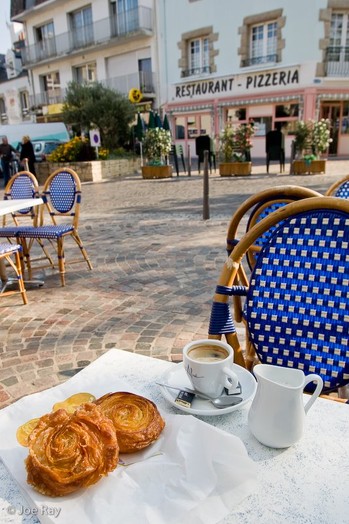
Monday, September 29, 2008
The Buttered One
QUIBERON - A Provencal friend of mine who claims to be ‘allergic to butter’ would perish in this town. Good thing she’s not here – more for me! Last night I had wonderful crèpes at La Duchesse Anne where melted butter is brushed on the hot galette (a crèpe made with buckwheat flour) before the ingredients are added and often brushed again before the finished dish goes out to the floor.
This morning, I stopped at the Boulangerie Bihan “Trois Marches†and picked up a pair of kouign amann – Breton for “cake†and “butter,†though they should have also added Breton for “lots of extra sugar,†which caramelizes around the whole thing and makes life good. Though they’re not particularly large, I learned that eating two is a bit like trying to get through an entrecôte pour deux personnes alone.
Luckily, my arteries and I were up for it. There’s a moment of crunchy, sugary goodness where your teeth stick together, then all at once, the butter gives up the ghost and becomes a liquid, full of so much flavor, I giggle.
Later, on the train back to Paris, I tasted another kouign amann that I brought from Quiberon’s famous Maison Riguidel - touted to be the city’s best. These were excellent – flatter and more cake-like in form, but Boulangerie Bihan’s got them beat, hands down.
SPECIAL NOTE: People of Quiberon, unite! Go to the Boulangerie Bihan (where I found my favorite kouign amann) and encourage the good woman running it not to close the bakery doors for good following the death of her brother the baker – she’s kept on running the bakery, but is talking of shutting it down within a month, taking one of the city’s tiny treasures with her.
Boulangerie Bihan “Trois Marches†34, rue de Verdun QUIBERON – 02.97.50.14.96 - MAP
Creperie Duchesse Anne - 10, Place Duchesse Anne QUIBERON - 02 97 30 49 33 - MAP
Maison Riguidel – 38, Rue de Port Maria, QUIBERION - 02.97.50.07.41 - MAP


Sunday, September 28, 2008
I Lied
I’ve been asked by French food writer Francois Simon to contribute to the English-language version of his blog, Simon Says. Simon is the food critic at Le Figaro and kind of like the character Anton Ego from the movie “Ratatouille” ...in dandy form. Want to freak out a French chef? Tell them Simon will be coming for dinner.
In parallel, The Boston Globe asked me to contribute to their travel blog, Globe-trotting, where my entries will show up next to award-winning journalists, Tom Haines, Lylah Alphonse and Ethan Gilsdorf.
To quote myself quoting “The Godfather” to help explain why a guy named Guido would use an umbrella to harvest mulberries from a tree in Sicily, it was an offer I couldn’t refuse.
So I’m blogging again. Here, on Globe-trotting and with Simon Says. Not just Sicily anymore, but France, Barcelona, across Europe and around the world. The Motherland is officially spreading its wings. But it’ll always be about food. Only the good stuff.
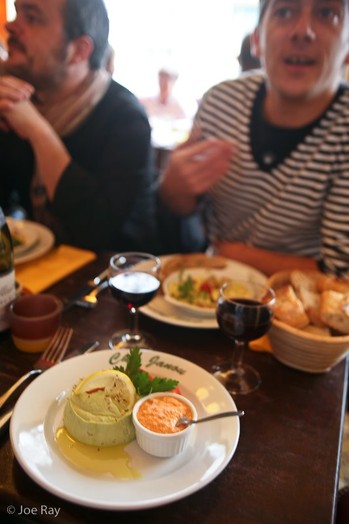
Sunday, September 28, 2008
Rites of Return
Signs that summer is officially over in France are everywhere: Parisians, a curiously thin-blooded breed, are even justifiably wearing sweaters and jackets (though they pulled the scarves out a couple weeks ago, bien sûr), the leaves in the Palais Royal garden are a depressing mix of green and brown, and yesterday on the Champs-Elysées, it was cold enough that all of the tables on the terrace outside of Fouquet’s – a.k.a. people watching heaven - were ornamental.
La rentrée – the post-summer return to school, work and life - is in full swing. After a month of gathering dust, keyboards in France are now clicking a gogo; the projects nobody was thinking about a month ago are underway. Suddenly, life moves fast again.
After a month on vacation, I fall into the same jarring trap.
In the middle of it all, a group of good friends I haven’t seen for months asks me to join them for lunch.
“No time!†screams a little voice in my head.
“No money!†says another.
“I’ll meet you there,†I say, ignoring them both.
Twenty minutes later, we are encased in a little bubble Chez Janou. Vincent’s wife is pregnant again, Seb is laughing and Calou, having just worked a week in Lourdes, is cracking jokes about the Pope. Four prix-fixe menus, a bottle of wine and everything is OK again.
Later, I swing by to pick up a fax that Rose, who runs the show at Chez Lucette in the 17th, is holding for me. She’s got a vendor in and I see her for all of 30 seconds, but she sends me off with a kiss on each cheek that cracks so loud my ears pop.
Stars officially realigned, I leave and walk down the street with a smile glued to my face.
Chez Janou : 2, Rue Roger Verlhomme 75003 PARIS 03. Tel: 01 42 72 28 41 Map
Chez Lucette, 43, rue de la Jonquière 75017 Paris Tel : 01 46 27 72 54 Map
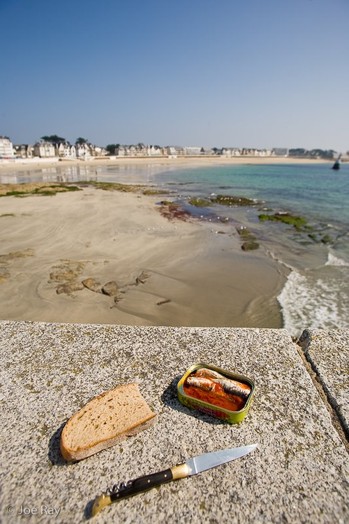
Sunday, September 28, 2008
Sardine is not a four-letter word
QUIBERON – After three and a half hours on an early train from Paris and another hour on the bus, the idea of sitting around tourists and retirees in a restaurant didn’t really float my boat. Returning from a meeting to set up an outing with a gooseneck barnacle fisherman, I walked right in front of the solution: La Belle-Iloise cannery.
Five minutes and a six-can variety pack of sardines later – everything from the little silver fish marinated in muscadet to two peppers, olive oil and lemon – I was in business. Sitting on the seawall, I ate a tin of sardine à la tomate served on pain Poilâne that I smuggled from Paris. Though there’s a fierce debate as to whether La Belle-Iloise or La Quiberonnaise makes the better sardine it didn’t seem to matter; in the space of five minutes, three people walked by jealously eyeing my picnic and smiling. One guy even offered up a “Bon Appetit!â€
On the bus, I had listened to an interview with Alice Waters who extolled the virtues of both cooking and eating with friends, yet here I was, straddling the seawall by myself, getting a sense of place from a can.
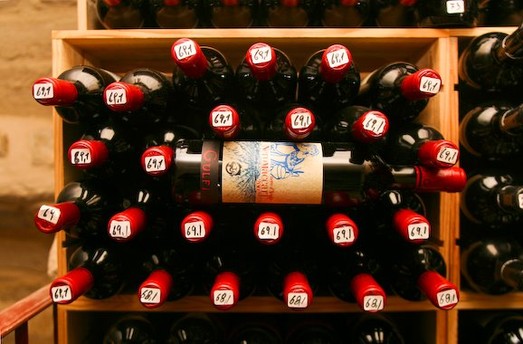
Friday, June 06, 2008
Standing up for an old friend
A year ago, Francesco and I would sit in the office at the end of a long day, uncork a bottle of Nero d’Avola and work on gaining a better understanding of the characteristics of Sicily’s best-known grape. Professional wine tastings can be a bit force fed – a winemaker might quickly say what you should be seeing, smelling and tasting. Picking these characteristics out on your own inevitably forces you to go slower than they guy at the front of the room. Taking the time to really understand just one wine is a luxury. And you can really learn something.
A year later, I learned something different.
“Nero,” says Francesco, making a diving motion with his hand, “is having a tough time.”
We opened a 2006 Nero di Lupo (a 2003 version of which we tasted last year when it was called Pojo di Lupo) and talked about it.
“Traveling in Italy and abroad, I started to notice its absence in the last couple of months,” says Francesco.
At Milan’s best wine shop, the owner put it to him bluntly. “Nero d’Avola? It’s over.”
The Nero di Lupo name change was a clue; after a several-year run as one of Italy’s trendiest wines, everybody wanted a piece of wines made with Nero. Producers started growing the grape in regions less suited to its production - often far from Avola. Though quality winemakers are still making excellent wines, the bottom of the market has been flooded, dragging the good wine’s good name down with it.
“It’s been sold improperly,” says Sicily’s top chef, Ciccio Sultano, who is upset with both rising Nero prices and an overall quality decline. “Demand grew, but the wineries multiplied…It’s too much.”
“Take Bordeaux - it’s crazy,” he says, pointing to his head, “you can’t justify the price. It’s for the Russians.
“What’s the difference between this and a Mouton Rothschild?” he asks, holding up a glass. “Is that 30 or 40 times better? It’s marketing. Wine is like a cuisine – there is art and craftsmanship, but it’s outrageous to pay too much for food and wine.”
Luckily, the good stuff is still out there. Though it took our Nero di Lupo three hours to open up (why they consider this stuff currently ready to sell at a grocery store is beyond me).
Once it was ready, it was a beautiful thing, full of autumn leaves along with more typical leather, licorice and berry smells. Flavors of orange zest and chocolate emerge.
“Eureka!” deadpans Francesco. “Sometimes, we face hard times in drinking.”
A few days later, after sitting in on an almond tasting with sensorial analyst, Giuseppe Cicero, the good doctor broke out a bottle of Terra delle Sirene, clearly one of his favorites.
Big, a little brash and quite tasty with almonds, this was the wine I remembered going nuts for last year.
“It’s not hard to find good red wine among the Sicilian wineries,” says Cicero who’s partial to one made by Rosso Del Conte.
We’re just going to have to do a little more homework.
This is Joe Ray reporting from the Motherland.
Saturday, May 31, 2008
A mouthful of memory
Yesterday, I interviewed a farmer in his Ferrari for a story about the Sicilian melon market. Taking notes in a car with a suspension-adjusting switch marked “RACE” is not unlike trying to do the same in a 4x4 bumping through an olive grove.
Meeting a couple of melon farmers yesterday, Mr. F430 included, I kept getting distracted by their tomatoes. Odd bedfellows, melons and tomatoes love the soil and hot climate around the southern Sicilian town of Pachino and have become the town’s financial backbone and its claim to fame.
Standing in a giant tomato greenhouse filled with the wonderful green smell of the vines themselves, Bruno Cicciarella (who drives a more modest ride pulls a fat thumb-shaped tomato he calls a ‘pixel’ from a cluster and hands it to me.
The taste isn’t perfect, but compared to what we’ve grown accustomed to from the grocery store, it’s mind blowing. It’s plenty enough to put me out on the back deck with my family, eating salted chunks of dad’s tomatoes straight from the garden.
I also try some tomatoes sold by Sebastiano Fortunato (a.k.a. Mr. Ferrari) and understand why he’s got such a fancy pair of wheels. His cherry tomatoes are so sweet, it’s easy to understand again why tomatoes are fruit.
Later, Francesco and I have a great glass or two of Sicily’s signature Nero d’Avola wine in my kitchen. It’s good reminder of why he and I spent a lot of time with our noses in glasses and turning our tongues purple a year ago trying to learn the flavor characteristics that make it such a good pour.
“Why do we have to be so technical when we try to describe a wine?” he wonders to no one in particular. It’s a fun question and a debate for which he knows and appreciates the arguments of both sides. “Why can’t we say this wine tastes like…The Police?” he asks, clearly thinking back to a good moment where he had the British trio on in the background.
In the end, what better compliment could you give than associating good food with a good memory?
I end the night with one of Cicciarella’s tiny melons. It’s a mouthful of summertime, past and present.
This is Joe Ray reporting from the Motherland.
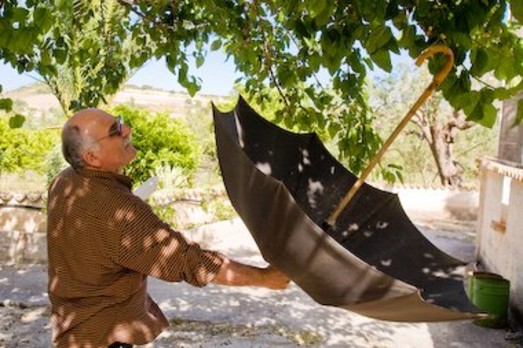
Monday, May 26, 2008
The Little World of Don Guido
This afternoon, I hitched a ride with Guido to his cabin where I figured I could work unconnected while he puttered around in the garden. He picked me up in his 1970s Renault R4 and headed back through Ispica for an impromptu tour of the old part of town.
“That’s my church,” he said, rounding a corner, cresting a hill and pointing out the window all at once. “Now, neutral!” he said, batting the old car’s dash-mounted stick shift back and forth with his hand and letting the car coast. Next, he passed through streets so narrow, I had previously thought it was a pedestrian area. “Modern cars don’t fit.”
Five minutes out of town at the cabin he uses both as an artist’s studio (he’s a well-known artist, with an affinity for mail art) and a base for his gardening, his mulberry tree has a carpet of fallen berries below it. A week after I was here last, the berries on the tree are now a little bigger, a little riper and a lot tastier. With high wire comic panache, Guido again brings out the umbrella and fills up a plate of berries for me to nibble on while I write.
Later, I help him sweep and shovel up the berries on the ground and return them to the earth as compost for his olive trees. Near a stack of firewood, he identifies four kinds of wood just by looking at the cross sections: carob, fig, almond and olive. I ask which type is the best for cooking.
“For baking bread?” he replies, “Olive. You take a few branches and throw it into the oven and it smokes, giving flavor to the bread.
“In the forties and fifties, when the olive trees were pruned, the farmers would put the bunched-up trimmings in bushels around the tree to dry. Later, they would load the bushels on a back of a cart and sell them in the countryside. At home, you would put a few bushels in the oven and let them burn,” he says. “When the tile in front of the oven was warm, you’d scoop out most of the cinders and put your bread dough in.
“Now, it’s different. Things are…” he trails off, whipping his hands around in the air looking for the word, “…globalized.”
There’s no malice in the word, he just uses it like the name of a country he’s never been to; he hasn’t reinventing the bread making process, he’s just sharing what he knows.
“Here, it’s peaceful,” he says. “Here, I’m good.”
“Here, have a glass of wine.”
This is Joe Ray reporting (hic!) from the Motherland.
